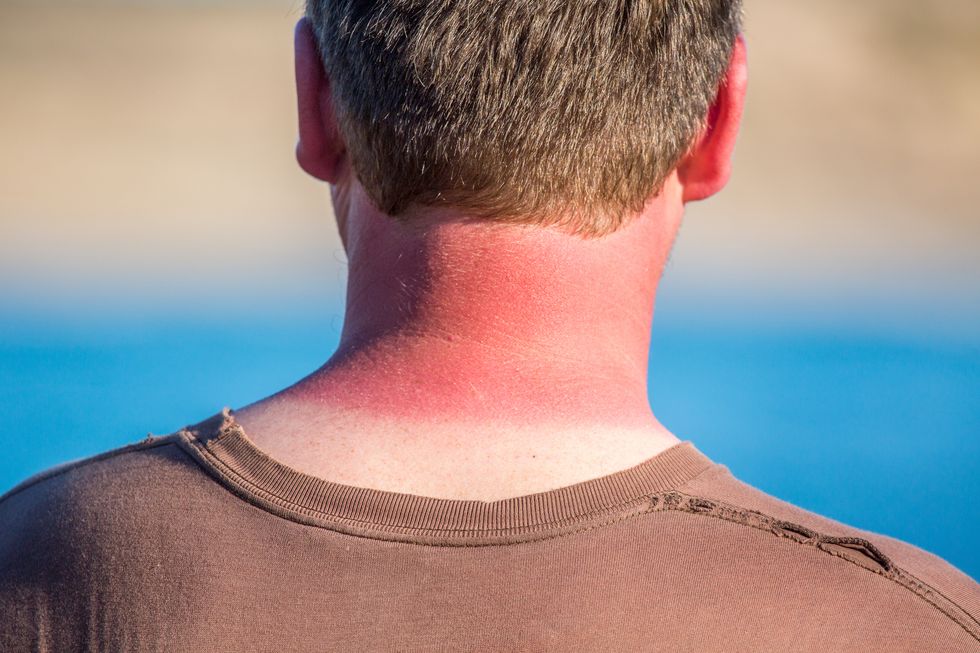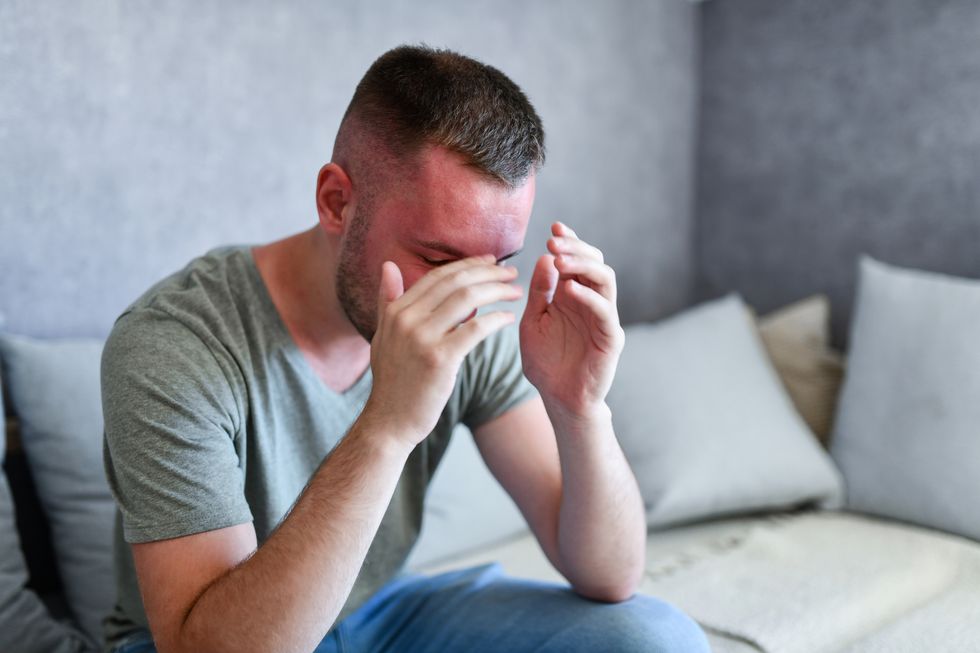WHEN YOU SPEND time in the sun, you know you need to apply (and reapply) sunscreen, drink lots of water, and take breaks in the shade. But it’s easy to get distracted hanging out outdoors with your friends and neglect these sun-protection habits.
And, that can lead to a serious sunburn—or, worse, it can cause sun poisoning.
“Sun poisoning is basically a really severe presentation of a sunburn,” explains Ife Rodney, M.D., a dermatologist and founder of Eternal Dermatology and Aesthetics in Fulton, Maryland. “If you have a really bad sunburn, you can get systemic symptoms like fever, chills, headache, dizziness, and nausea.”
The term “poisoning” is a bit deceiving, as the sun isn’t exactly “poisoning” you, says Steven Rasmussen, M.D., a dermatologist at Austin Regional Clinic in Austin, Texas.
“When sun poisoning occurs, the injury to the skin due to the sun’s radiation causes intense inflammation in the skin that results in a more generalized inflammatory reaction in the whole body,” he explains.
Some people with specific skin types are more susceptible to sunburn and sun poisoning than others, Dr. Rodney says.
The condition is usually preventable, and there are several ways to treat it. However, unlike a bad sunburn, sun poisoning may require immediate medical attention, and you may land in your local urgent care or emergency room.
Here’s what you need to know about sun poisoning, including the symptoms, what to do if you get it, and when to seek medical attention.
What exactly is sun poisoning?
Sun poisoning is a more severe form of sunburn, explains Simran Sethi, M.D., an internal medicine physician, medical director of RenewMD, and host of The Skin Report Podcast.

Both conditions mostly affect the superficial layer of the skin, known as the epidermis, she says. With sun poisoning, however, there’s greater damage to the dermis, which is the deeper skin layer where proteins like collagen and elastin reside.
“Sun poisoning occurs when there is extended exposure to ultraviolet rays which results in breakage of the skin barrier,” Dr. Sethi says. “Essentially, if you do not get out of the sun, despite experiencing the symptoms of a sunburn, that extra time in the sun will lead to sun poisoning.”
Signs of Sun Poisoning
A typical sunburn usually results in red, warm, itchy, or tender skin due to UV radiation from the sun, says Dr. Rasmussen.

Sun poisoning, however, can result in large and painful skin blisters. “The redness and blistering also lasts for more days than with a sunburn,” Dr. Sethi says.
With sun poisoning, you’re also likely to experience facial swelling, lightheadedness, dehydration, chills, headache, fever, nausea, and vomiting, Dr. Rodney adds. Sometimes, these symptoms are severe enough to need medical attention.
“I think of sunburn as being just more localized to the skin and sun poisoning being where the symptoms spread beyond the skin,” she explains.
Since sun poisoning starts with symptoms that are similar to sunburn, the illness can go unnoticed, which increases the likelihood that symptoms will worsen, says Dendy Engelman, M.D., a dermatologic surgeon in New York City.
How does sun poisoning happen?
Sun poisoning is caused by extended exposure to the sun’s UV rays without protection, Dr. Rodney says.
That means not wearing sunscreen or forgetting to reapply it if you’re spending a long time outdoors or are swimming or sweating, she explains. You can also increase your chances of gettin sun poisoning if you don’t drink enough water while spending time in the sun.
“If you’re not drinking a lot of water, it would worsen the symptoms of sun poisoning,” Dr. Rodney adds. “When your skin gets sunburned, the skin barrier is compromised and you have a loss of fluid from the skin’s surface. That’s how you can get dehydration.”
Who’s most likely to experience sun poisoning?
Anyone can get sun poisoning. However, individuals with lighter skin tones are more likely to get sunburn and sun poisoning, Dr. Sethi says.
“This happens because lighter skin tones have less of the kind of melanin pigment that filters out the effects of UV exposure,” she explains. People with darker skin tones have more melanin pigment that protects them from the effects of UV rays.
Taking certain medications, like antibiotics, antifungals, or antihistamines might make you more sensitive to the sun and potentially increase your risk for sun poisoning, Dr. Rasmussen says. Individuals with medical conditions such as lupus that make them more susceptible to sunburns are also at higher risk.
“Additionally, when and where the sun exposure occurs can be [a factor],” Dr. Rasmussen says. “Exposures during peak times of the sun’s radiation (usually 10 a.m. to 4 p.m.) and high altitude exposure increase the risk.”
How to Treat Sun Poisoning
Once you realize you’re dealing with a serious sunburn, it’s important to act quickly, Dr. Rasmussen says.
“Immediately seek shade, take a cool (not cold) shower, or apply cool compresses,” he says. Don’t apply ice or anything cold directly to the skin, which can further damage the skin’s barrier. “Make sure to also hydrate and apply [aloe vera gel] or moisturizer, and avoid sun exposure to the affected areas.”
Rehydration is crucial, Dr. Sethi adds. Dehydration is a common symptom of sun poisoning, and remaining dehydrated will result in longer-lasting skin symptoms.
Take ibuprofen or Tylenol to help with the pain, discomfort, or fever, she says. Also apply a layer of 1 percent hydrocortisone cream to your sunburn, followed by aloe vera every few hours.
“Aloe has calming, anti-inflammatory properties,” adds Dr. Engelman. “When applied to the skin, it reduces redness and helps increase healing time.”
Other home remedies include witch hazel, which has anti-inflammatory and astringent properties that help with itching and irritation, Dr. Engelman says. Mixing oatmeal with olive or coconut oil and applying it to your body before a shower or a bath has soothing effects.
When to Seek Medical Care for Sun Poisoning
Get medical attention if your sunburn causes large, painful blisters, facial swelling, flu-like symptoms, headache, confusion, dizziness, or signs of dehydration, according to Dr. Rasmussen. Don’t feel silly about going to urgent care or the ER—sunburns account for tens of thousands of medical visits every year, he says.
“If your burn is accompanied by blisters that cover more than 20 percent of your body, you definitely need to see a doctor who will assess the burn and provide the best treatment for you,” Dr. Engelman adds.
Depending on your case, doctors may prescribe antibiotics if you have ongoing fever or broken skin, Dr. Sethi says. You might also need steroids to reduce excess inflammation or intravenous fluids if you’re dehydrated.
How can you prevent sun poisoning?
Just like sunburns, sun poisoning is absolutely preventable. You can prevent sun poisoning similarly to how you’d protect yourself from general sun damage, Dr. Rasmussen says.

That means avoiding sun exposure during peak times, he adds, and wearing sun-protective clothing, including hats, shirts, and pants.
And, don’t forget the sunscreen. Wear broad-spectrum sunscreen that’s SPF 30 or higher and reapply it at least every two hours or more frequently if you’re swimming or sweating, Dr. Rodney says.
“You have to make sure that you put on a nice, thick layer of sunscreen on all sun-exposed areas,” she emphasizes. “Not just your face, but your neck, arms, behind your ears, everywhere.”
